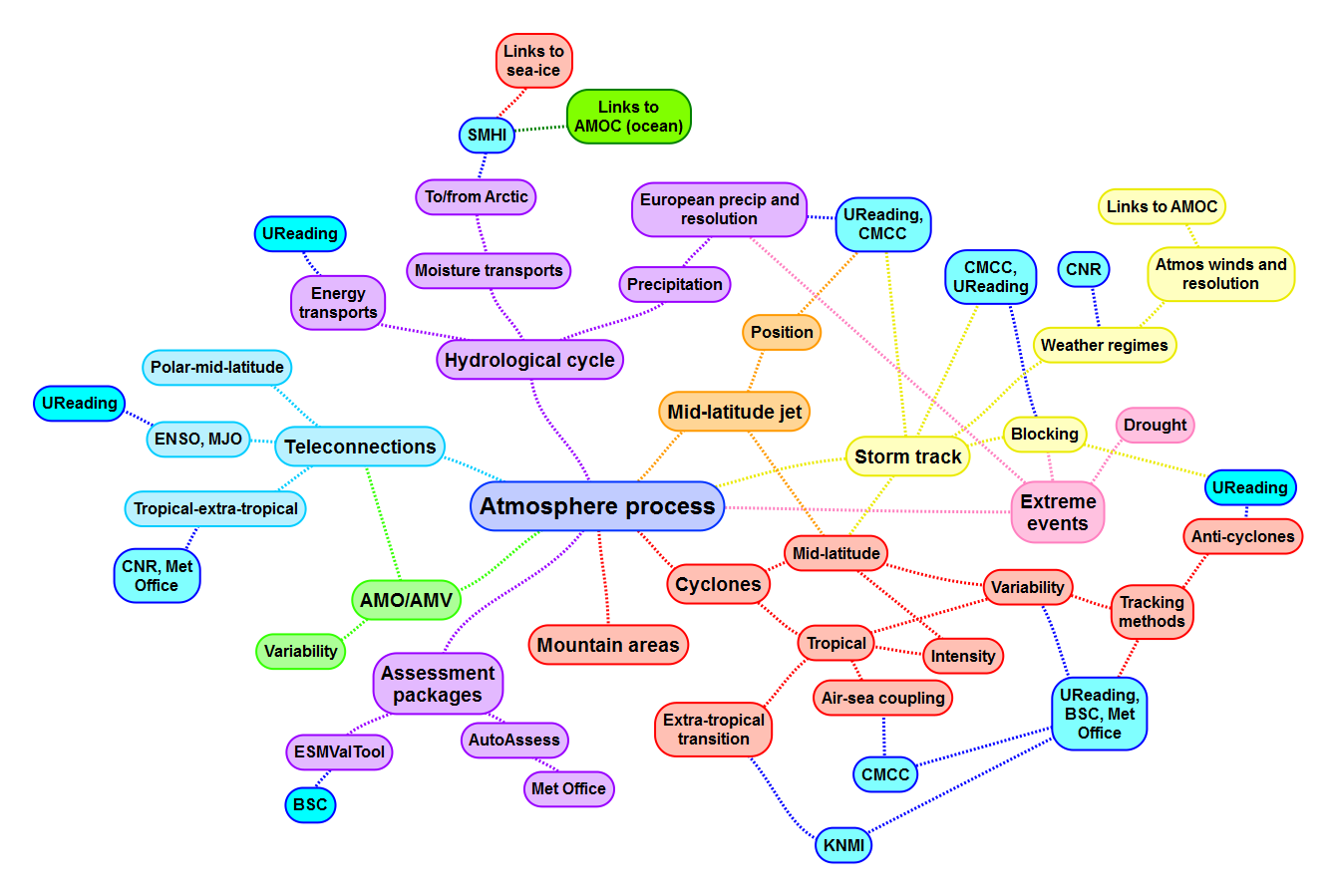
Atmospheric research areas
The above mindmap is illustrative of some of the atmospheric processes that are important to for climate models to represent adequately particularly for European weather and climate, and that we have expertise in researching.
Hydrological cycle
Many of the impacts of climate variability and change are felt through changes to the water cycle - floods, droughts, and extreme rainfall. We also had evidence from previous work (Demory et al. 2014) that increased resolution could impact the moisture transports from ocean to land, though global observations are quite uncertain whether this is an improvement. The recent paper (Vanniere et al. 2019) builds on this work, suggesting an important role for model resolution, and the representation of orography, in model biases of precipitation. There are links to many of the other atmosphere and ocean processes.
Mid-latitude jet
The behaviour of the North Atlantic mid-latitude jet, particularly its intra-seasonal variability, was not captured by many global climate models participating in CMIP5 (e.g., Iqbal et al., 2018), despite improvements over previous model generations. This has implications for how well-represented are important aspects of European climate downstream, including weather extremes and the frequency of severe prolonged anomalies such as cold spells (Woollings, 2010). Previous research indicated that increased model resolution may allow for better jet simulation (Zappa et al., 2013). PRIMAVERA models capture the behaviour of the North Atlantic jet well, which is an important result for North Atlantic climate, but inter-model differences exist. We have found some evidence that the observed negative relationship between jet latitude variability and jet speed is captured better at high-resolution, indicating that resolution is important for some large-scale features of the climate system.
Storm track
The storm track in the North Atlantic (that is the path where storms tend to cross the ocean from the North American region to Europe) is a key region for climate processes as well as a variety of impacts on Europe (from storm damage to wind power). Improved modelling of the dynamics of storms and the storm track will hopefully help to give more robust projections of future change, which is very uncertain from previous IPCC reports (some models project the storm track to move south, some north, some unchanged).
Blocking
Climate models suffer from long-standing biases in atmospheric blocking. In agreement with studies for previous model generations we find that the PRIMAVERA Stream 1 simulations generally underestimate the occurrence of blocking. Both in winter and summer, too few blocking events are simulated in the Euro-Atlantic region, and the events that do occur do not last long enough. While increases in model resolution, from O(100 km) to O(20km), do not eliminate these biases, higher-resolution simulations show an improved model performance for blocking. This concerns in particular the geographical pattern of where blocking occurs, while the persistence of blocking improves only a little with model resolution. A new finding from PRIMAVERA over a predecessor study with a multi-model ensemble of atmosphere-only models (Schiemann et al. 2017) is that the improvements in blocking are larger when both ocean and atmosphere resolutions are increased, arguably due to smaller SST biases in higher-resolution coupled models.
Cyclones
Cyclones can be found in the tropics (where they arevariously called tropical cyclones, hurricanes, typhoons, cyclones) and in the extra-tropics (mid-latitude storms). The scales of these systems is very different, with the core of tropical storms being of order 100's km, while those in the extra-tropics are typically 1000km in size.
Tropical cyclones
Climate models have historically struggled to represent tropical cyclone properties with much fidelity (such as intensity measured by windspeed) due to the grid spacing. Our models, approaching 25km grid spacing, have a better chance to capture more aspects of tropical cyclone intensity, as well as their interannual variability, and their coupling to the ocean which is also important (e.g. Scoccimarro et al.).
Extra-tropical cyclones
These types of storms can bring extremes of wind and rain to Europe. Although they are large and in theory well-resolved by standard climate models, we do find evidence that enhancing resolutions to 25km can bring benefits to their simulation.
Mountain areas
Atlantic Multidecadal Oscillation/Variability (AMO/AMV)
The Atlantic Multidecadal Oscillation (AMO) is a major driver of climate impacts in many parts of the world. It is characterised by a long-term observed warming and cooling cycling of the North Atlantic Ocean. The ultimate origin of this variation is still a matter of scientific debate, however the wider impacts on climate are becoming better understood, through the use of climate models. Two aspects of the climate impact that remain unexplored are the role that coupling (between the ocean and atmosphere) and model resolution play. PRIMAVERA seeks to examine and quantify these aspects through a set of coordinated multi-partner coupled model experiments.
Teleconnections
Teleconnections are defined as processes that happen remotely from the area of interest, but then influence the local area. Examples would include tropical processes such as ENSO (El Nino-Southern Oscillation), the see-saw of tropical Pacific temperatures that can also influence European weather and climate. The Madden-Julian Oscillation (MJO), a primary sounce of tropical intra-seasonal variability, can also impact on European weather.
